Sustainability dimensions in goods movement
The section “Sustainability dimensions in goods
movement” provides you with an overview of the three pillars of sustainability
– society, environment and economy – and its importance for goods movement.
3. Ecological dimension
On the following page the ecological dimension of sustainability will be explained to you. After showing you the consequences of climate change and GHG emissions on the world we are talking about the reporting standards for companies and explain you, how to calculate emissions from goods movement.
Transport and environment
The following figure „Share of different modes of transport in energy consumption and NO2 emissions” shows the different movables and their transport energy consumption in 2022 such as their Nitrogen dioxide (NO2) emissions in 2021 from road traffic. NO2 is a corrosive irritant that is released during combustion processes in systems and engines. It contributes to particulate matter pollution and can increase the risk of dying from cardiovascular diseases and also contributes to the over-fertilisation and acidification of soils.

In Germany, 2.5 acres of new land was taken up for transportation purposes each day in 2019. Every year, 111,420 tons of plastic microparticles are released by tire abrasion into the environment in Germany alone. In 2017, 13.2% of the population in Germany was affected by sound levels above 50 decibel (dB(A)). 50 dB(A)corresponds to a normal room volume and is just about comfortable for us. Outside the home, average noise levels above 55 dB(A) are likely to have an increasingly negative impact on our mental and social well-being.
Why is the focus on carbon dioxide (CO2) or equivalent balances?
The following figure “CO2 emissions worldwide 2021” shows the emissions in the sectors transport, buildings, other industrial combustion, power industry and other sector.
There is a linear dependence of CO2 on energy use (regardless of the kind of fuel). The anthropogenic CO2 is the GHG number 1. Greenhouse gases are a group of gases contributing to climate change and global warming and are explained to you below. Worldwide, 20 % of global CO2 emissions are caused by transport (passengers and goods). There exist policy steering parameter like the Kyoto Protocol. In a non-binding communiqué issued on June 7 2007, it was announced that the G8 nations would ‘aim to at least halve global CO2 emissions by 2050’.
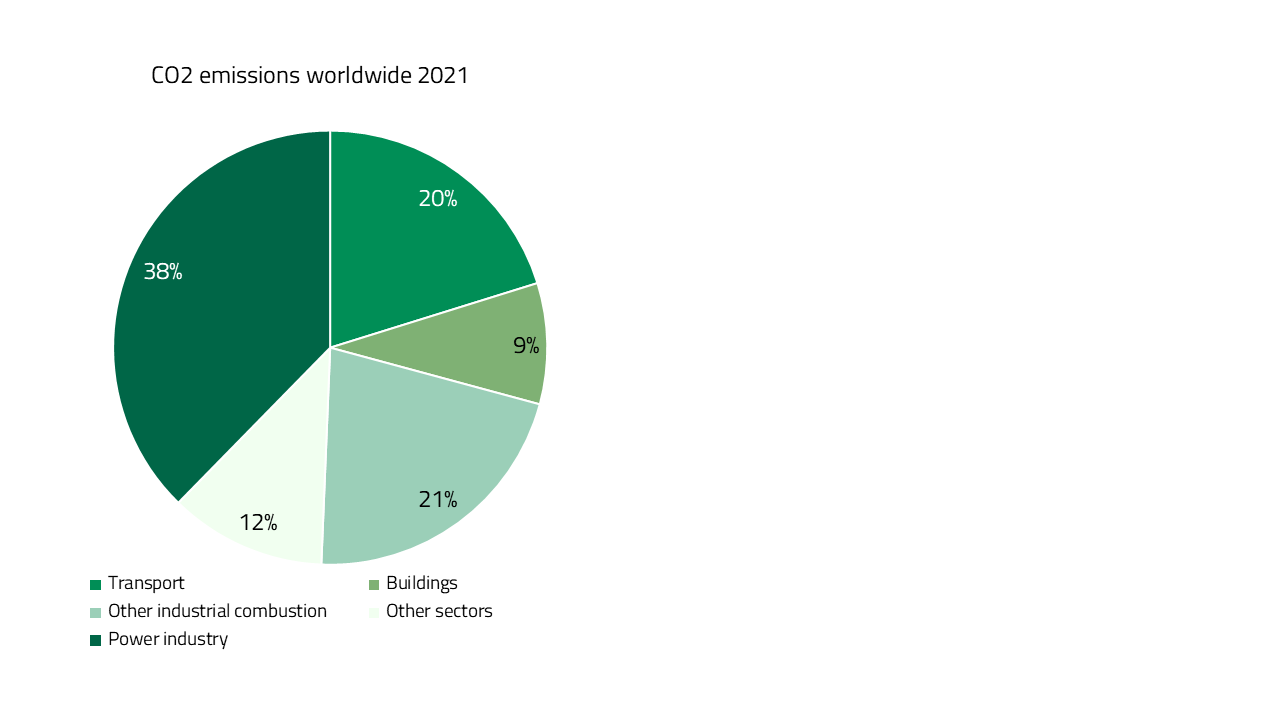
The logistics sector is highly dependent on fossil fuels and has a high growth rate. In total, Logistics accounts for 10-11% of global CO2 emissions, where
- the Transport of goods accounts for approx. 8%
- the Storage and terminals accounts for approx. 1-2%
- while the accounts for Administration and IT are unknown.
Use of resources
The following figure "Relationship between transport, resource consumption and environmental use" shows, how the use of resources like raw materials, area, water but also infrastructure, vehicles and operation leads to emissions and immissions. The resources are needed for handling, storage and traffic. Sometimes, a substitution of traffic through bits and bytes is possible, but this also leads to resource consumption and emissions from different resources and emissions elsewhere (spatial shift of the problem).
Traffic can be generated by different movables (e.g. airplane, truck, train) and leads to emissions like air, noise, light or vibration. Those emissions themselves are leading to immissions for human beings or animals.

Consequences of climate change
The consumption of resources and the resulting emissions and immissions lead to an increase in temperature. This ongoing temperature changes have an impact on several aspects e.g. weather, water, food and the ecosystem. The following figure “Consequences of climate change” shows, how different temperature changes are impacting the weather, water, food, ecosystem, social and the gross domestic products. An increase of just 1 degree will threaten water supplies through melting glaciers and results in a crop yield decline in developing countries, a severe and irreversible damage to ecosystems, a first refugee movements (‘climate refugees’) and a reduction in GDP in developing countries. From a 2 degree increase, there will also be an increase in extreme weather events, a water shortage for up to one billion people and the extinction of many animal species. At the UN Climate Change Conference (COP21) in Paris 12 December 2015, 196 parties adopted a legally binding international treaty on climate change. The goal is to hold “the increase in the global average temperature to well below 2°C above pre-industrial levels” and pursue efforts “to limit the temperature increase to 1.5°C above pre-industrial levels.” (United Nations 2015)
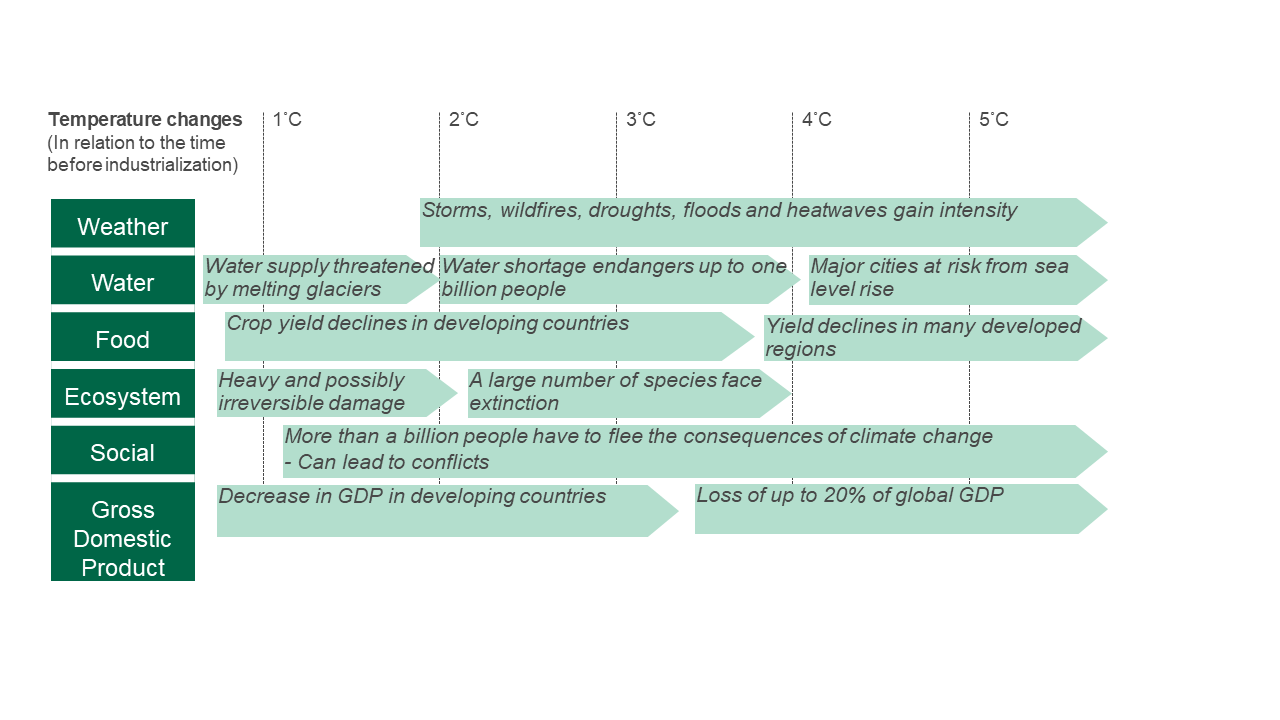
Definitions of Greenhouse gas
When talking about emissions, climate change and global warming, the three terms GHG, GWP and CO2e are often used, which are defined according to the ISO 14083 as follows:
Greenhouse gas (GHG): Gaseous constituent of the atmosphere, both natural and anthropogenic, that absorbs and emits radiation at specific wavelengths within the spectrum of infrared radiation emitted by the Earth's surface, the atmosphere and clouds.
Global warming potential (GWP): Index, based on radiative properties of GHG, measuring the radiative forcing following a pulse emission of a unit mass of a given GHG in the present-day atmosphere integrated over a chosen time horizon, relative to that of carbon dioxide (CO2).
Carbon dioxide equivalent (CO2e): Unit for comparing the radiative forcing of a GHG to that of carbon dioxide. The carbon dioxide equivalent is calculated using the mass of a given GHG multiplied by its global warming potential.The following figure “Greenhouse Gases - Originator, Gases and GWP” shows you the different greenhouse gases like carbon dioxide, methane, nitrous oxide and f-gases, its formula, GWP (in 100 years) in CO2eq and primary source. Furthermore, the graphs provide information about the originators of the gases and the distribution of the gases. 19,1 % of the GHG emissions originate from transport. From the GHG, 88% are CO2, 6,1 % Methane, 4,1 Nitrous oxide and 1,7 % F-gases.
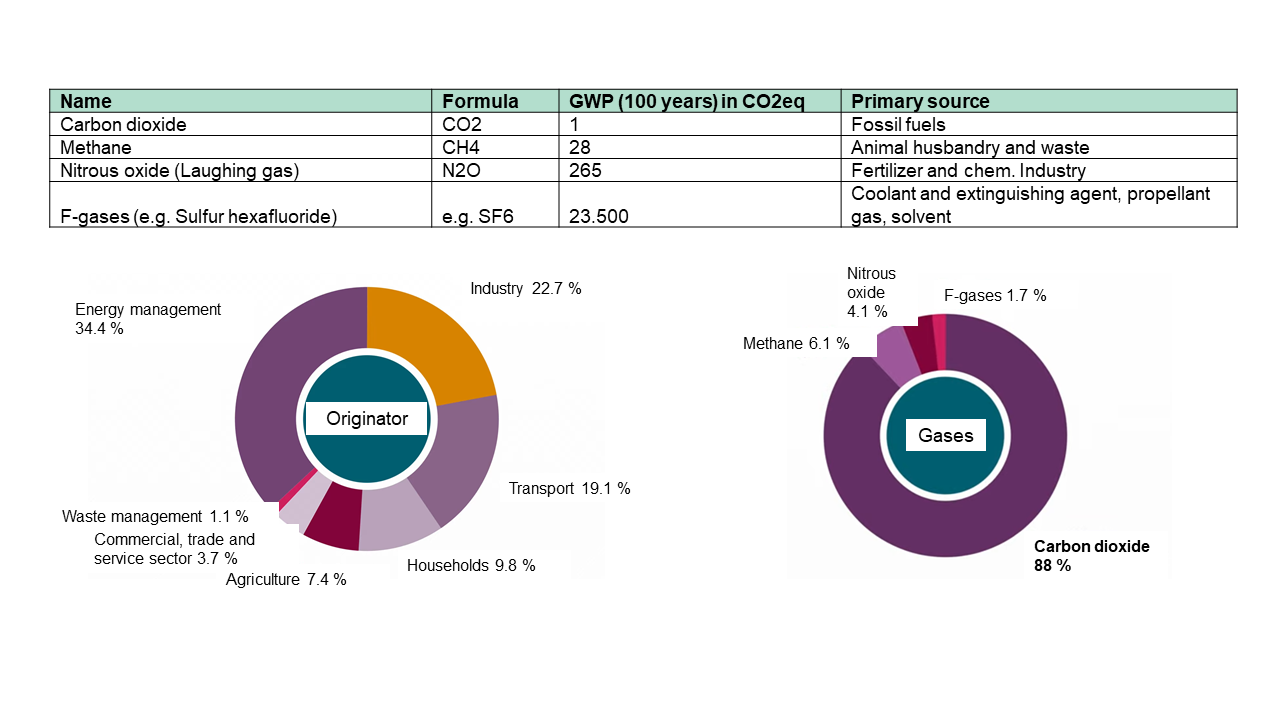
Legislation
As already mentioned on the previous pages, the EU has issued important legislations for the past and coming years to ensure a standard for sustainable behaviour. The following figure “Legislations: Affected companies and relevance for SMEs” (small and medium-sized enterprises) shows you four important legislations (Regulations and Directives) for Germany and Europe and the companies affected. While the LkSG (Lieferkettensorgfaltspflichtengesetz) is a German regulation, the EU taxonomy as well as the CSRD (Corporate Sustainability Reporting Directive) and the CSDDD (Corporate Sustainability Due Diligence Directive) are EU directives that are defining goals, EU countries must achieve.
The four legislations are explained in detail below.

LkSG
EU taxonomy
The EU taxonomy regulation (EU) 2020/852 is a classification tool for corporate activities and their contribution to sustainability and a reference point for investors to assess the sustainability of companies. It is a mandatory reporting since 2022 and is established for benchmarks and values. The objectives are more investments in sustainable technologies and companies and to encourage companies to act "greener”. The scope of application is large capital market-oriented companies with more than 250 employees that are not financial companies and have a net sales of 50 million € or a balance sheet of more than 25 million €. Furthermore, it also applies to listed SMEs and other companies. The EU taxonomy should provide criticism of the classification of individual activities (e.g. gas and nuclear energy).
The EU taxonomy has the following six environmental goals:
- Prevention of climate change
- Adaptation to climate change
- Sustainable use and protection of water and marine resources
- Transition to a circular economy
- Pollution prevention and control
- Protection and restoration of biodiversity and ecosystems
The EU taxonomy was amended on 4 June 2021 as part of a delegated regulation. It stipulates that the following substantial contribution to climate change adaptation must be done by the freight transport services by road:
- The vehicles should not be intended for fossil fuel transportation
- The vehicles (N1, N2, N3) must be reusable or recyclable to a minimum of 85 % by weight
- From 1 January 2026, vehicles in category N1 may no longer cause direct CO2 exhaust emissions
- Vehicles in categories N2 and N3 with a technically permissible maximum mass of 7.5 tonnes or less must be ‘zero-emission heavy-duty vehicles’* or, if this is not technically and economically feasible, ‘low-emission heavy-duty vehicles’*
A critical aspect of the taxonomy is that only direct emissions are assessed and that transport companies have to retrofit their vehicle fleets.
The current status of the EU taxonomy can be found here and the EU taxonomy here.
CSDDD
The CSDDD obliges large European and foreign companies throughout the EU to comply with certain environmental and human rights standards in their supply and value chains. It is built on the LkSG, but extends the environmental due diligence obligations and also includes chemical-related obligations and obligations to protect biodiversity, endangered species and specially protected areas and seas. In addition, companies must draw up and implement a plan to minimise their impact on climate change. To this end, companies must ensure that their business model and strategy are compatible with limiting global warming to 1.5 degrees and the transition to a sustainable economy.
You can find more information on the CSDDD here and the directive here.
CSRD
The "Corporate Sustainability Reporting Directive - CSRD," Directive (EU) 2022/2464 entered into force on 5 January 2023. With this directive large and listed companies are required to publish regular annual reports on their social and environmental risks and explain how their activities affect people and the environment.
The first companies will have to apply the new rules for the first time in the 2024 financial year, for reports published in 2025. With the CSRD, the number of companies in the EU that must publish reports will significantly increase from 11,600 to up to 49,000. (~15.000 in Germany). From the 2026 financial year, listed small and medium-sized enterprises (more than 10 employees and/or more than 450.000 € total assets and/or more than 900.000 € net annual turnover), small and non-complex credit institutions and captive insurance companies must also prepare a CSRD report. Micro-enterprises are exempt from this directive.
The CSRD includes the following innovations:
- Expanded and standardized reporting requirements: Companies are encouraged to adapt their reports and adhere to uniform rules. This enhances measurability and comparability through figures and data. The rules are developed by the European Financial Reporting Advisory Group (EFRAG).
- Redefinition of materiality: The requirements for sustainability reporting introduce the concept of double materiality. Companies must now report how their activities affect society and the environment and how important sustainability is for themselves. Previously, they only had to report if both aspects were significant.
- Mandatory external audit: Similar to financial reports, sustainability reports must now also be audited by a third party according to specific standards. The exact auditing rules are determined by the EU Commission. Initially, an audit providing "limited assurance" is required, but this will later be expanded to "reasonable assurance," similar to the auditing of financial reports.
- Integration into the management report: To ensure sustainability information is easily accessible, it must now be included in the management report. This highlights the increasing importance of sustainability reports, similar to financial reports.
You can find more information about the current status of the CSRD here and the CSRD here.
There are also more product-related sustainability policies and regulations, that are listed below:
- REACH Directive (1907/2006/EC)
- WEEE Directive (2002/96/EC)
- Buildings Directive (2002/91/EC)
- RoHS Directive (2002/95/EC)
- European Energy Star (2422/2001/EC)
- Landfill Directive (99/31/EC)
- Packaging Directive (94/62/EC)
- Batteries Directive (91/157/EEC)
- Fluorescent Lighting (2000/55/EC)
- Domestic Refrigeration (96/57/EC)
- Hot-Water Boilers (92/42/EEC)
- Energy Labelling (92/75/EEC)
GHG Protocol scopes and emissions across the value chain
The Greenhouse Gas Protocol with World Business Council for Sustainable Development and World Resources Institute (WRI) are the main drivers to develop calculation and evaluation standards for companies. The first standards for products and supply chain GHG (scope 3) were developed at the end of 2011.
The following figure “Illustration of the Greenhouse Gas Protocol” shows the Scopes 1, 2 and 3 of emissions and the indirect and direct effects (CO2 (carbon dioxide), CH4 (methane), N2O (nitrous oxide), HFCs (hydrofluorocarbon), PFCs (perfluorcarbon) and SF6 (sulfur hexafluoride)). Scope 1 emissions cover emissions controlled or owned by a company e.g. burning fuel in the fleet of company vehicles. Scope 2 emissions are indirectly generated emissions resulting from the use of purchased electricity, steam, heat or cooling. Scope 3 emissions include all other indirect emissions caused by a company's activities in its value chain that are not produced by a company itself. This includes in the upstream activities e.g. upstream transport and distribution, waste generated in operations, business travel or other purchased goods and services. The downstream activities for scope 3 emissions include the downstream transport and distribution, the processing and utilisation of products sold, the end-of-life treatment of products sold or franchises and other investments.
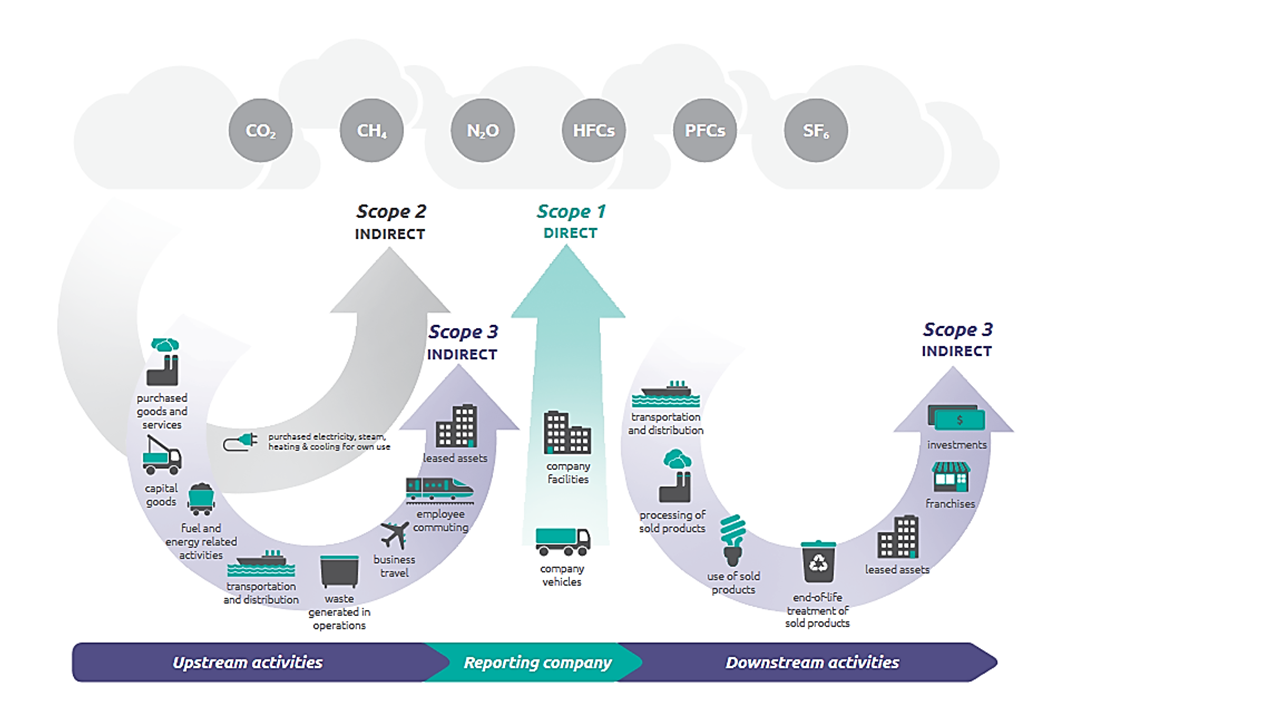
According to the GHG Protocol (2004) and the International Organization for Standardization (ISO) 14083, the General GHG Accounting and Reporting principles for companies are as follows:
- Relevance: GHG sources, GHG sinks, GHG reservoirs, data and methods are selected according to the needs of the intended user.
- Completeness: All relevant GHG emissions and removals are included.
- Consistency: Meaningful comparisons of GHG-related data are made possible.
- Transparency: Sufficient and appropriate GHG-related information is disclosed to enable intended users to make decisions with reasonable confidence.
- Accuracy: Deviations and uncertainties are reduced as far as possible.
- Conservativeness: When evaluating comparable alternatives, a selection is made that is cautiously moderate.
Standards
- ISO 14001: environmental management systems
- ISO 14040/14044: life cycle assessment (LCA)
- ISO 14064: Tools for evaluation, verification and reporting of GHG emission
- ISO 14067: Carbon Footprints of Products
- ISO 14083: Greenhouse gases — Quantification and reporting of greenhouse gas emissions arising from transport chain operations
ISO 14083 – Quantification and reporting of greenhouse gas emissions arising from transport chain operations
ISO 14083 is a set of guidelines for the calculation and reporting of greenhouse gas emissions caused by the transportation of people and goods. As such, it is primarily used by companies or individuals operating in the logistics sector. The standard was published in March 2023 and replaces the EN 16258:2021 "Methodology for calculation and declaration of energy consumption and GHG emissions of transport services (freight and passengers)". In addition to the transport operations contained in the old standard, the new ISO 14083 also includes processes and the associated GHG emissions at locations (hubs) that enable the transfer of passengers or freight
The standard includes the following aspects:- Requirements and guidance for the quantification, assignment, allocation and reporting of greenhouse gas (GHG) emissions for transport chains for passengers and freight.
- Claim of universal use (e.g. both multinational organizations with multimodal transports and small regional carriers).
- GHG emissions from vehicle and hub operations (Scope 1).
- Explicit integration of associated energy provision (Scope 2).
- The standard includes freight and passenger transportation
- Focus on Scope 1 and 2 of transportation operations.
The ISO 14083 contributes to the carbon footprint of products (ISO 14067) and companies (ISO 14064) as well as to the life cycle assessment (ISO 14040 and ISO 14044). An isolated application of the standards is not intended. It illustrates interaction with other ISO standards in the ISO 14040 and ISO 14060 series and uses a product purchased online as an example. The GHG emissions intensity per tonne-kilometer (tkm) calculated according to ISO 14083 can be used as primary or secondary data for GHG quantification projects and the data would need to be adjusted or modified for this purpose to reflect GHG emissions on a whole life basis.
For the GHG inventory of a company, the ISO 14064-1 can be used. One component here is emissions from transportation. For calculating the emissions from transportations, the different steps of the product need to be taken into account. For calculating the carbon footprint of a product, the ISO 14067 can be used. In order to calculate the GHG emissions from the transport chain, the ISO 14083 is used. The Principles and framework for LCA in ISO 14040/44 are taken into account the ISO 14083 and ISO 14067. The results from the ISO 14067 and ISO 14083 are included in the GHG inventory and report, transport chain GHG report and Carbon Footprint of Products (CFP) study, which are used for the GHG statement. The GHG statements can be verified and validated by using the ISO 14064-3, which builds upon the ISO 14065 (General principles and requirements for bodies validating and verifying environmental information).
According to ISO 14083, reporting must take place at least once a year. The levels of reporting contain the overall organisation (e.g. company or group) such as the transport and hub services. The following figure “Reporting contents in accordance with ISO 14083 for organisations/transport and hub services" shows you the duties and optional reporting contents of the organisation and the transport and hub services in detail.
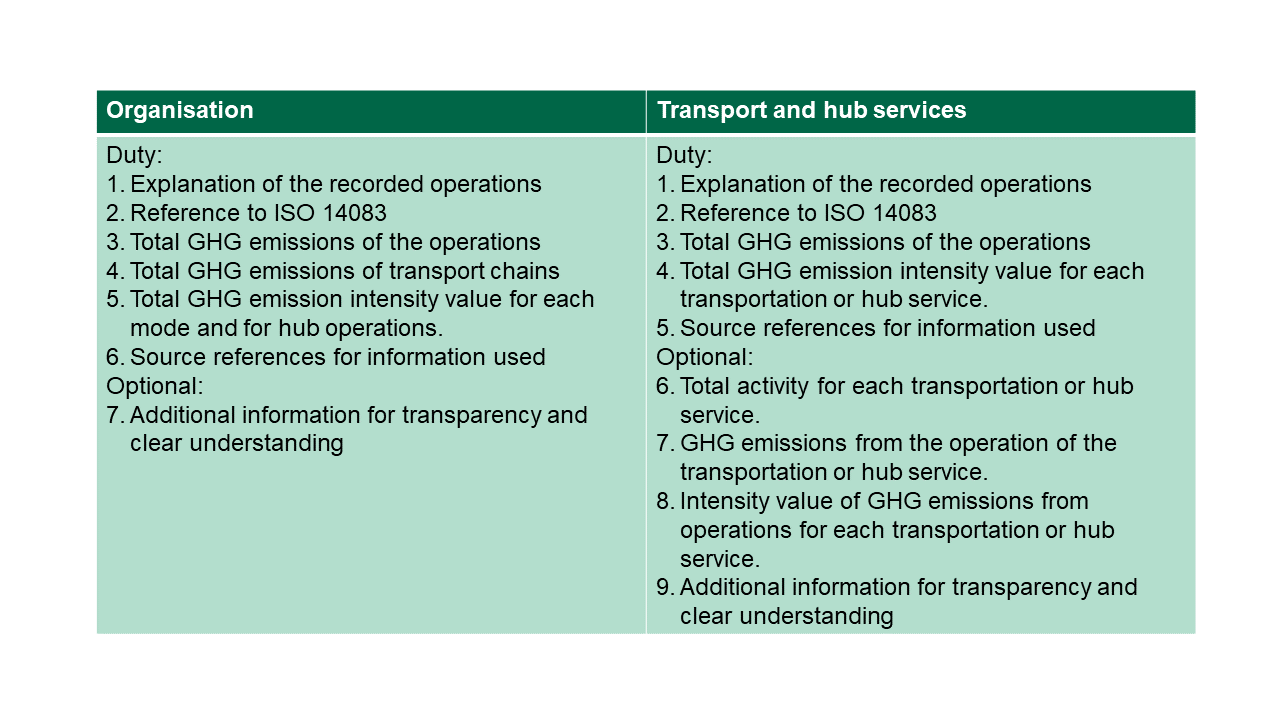
Transport chain-related GHG emissions considered in ISO 14083
Greenhouse gas emissions from the following categories are taken into account in ISO 14083:
- vehicle operation
- lifting process
- energy supply for the vehicle
- energy supply for the hub
- packaging life cycle (GHG packaging life cycle)
- grams (g),
- kilograms (kg)
- or tons (t)
In order to quantify the GHG emissions of the transport chain, the transport chain must be divided into successive Transport Chain Elements (TCE). The TCEs reflect the associated vehicle types, tube capacities and hubs that transport, handle or transfer freight and/or passengers as part of the overall transport chain. As an example, the transport chain can be divided into five TCEs, which are required for the greenhouse gas calculation. The TCE 1 and TCE 5 are representing road services, while the TCE 2, 3 and 4 are part of the shipping services. TCE 3 stands for the transport by ship, while TCE 2 and 4 include transshipment activities. The transport chain starts from the Freight consignor and ends at the Freight consignee.
TCEs can represent the following elements of the transport chain:
- Transport:
- All modes of transportation (road, rail, inland waterways, sea, air, and pipelines)
- All means of transport (e.g. ship, vehicle, aircraft)
- Transshipment between two TCE
- Hubs and terminals
- Empty runs due to subsequent transport
In order to quantify the GHG emissions, information needs to be exchanged between the participants in the transport chain.
Approach for the quantification of GHG emissions
If you want to quantify the GHG emissions, you can follow this five steps approach.
Step 1: Definition of system boundaries (SB)
Step 2: Determination of consumption and transport data
Step 3: Determination of emission factors
Step 4: Calculation of GHG emissions
Step 5: Documentation of results
Step 1: Definition of the system boundaries
The figure "Definition of system boundaries of GHG emission quantification" supports you in defining the system boundaries. It shows, which processes are included, e.g. all processes of the vehicle operation, all operational processes of the hub and all energy sources used. For this, you need to consider the entire life cycle of the energy sources used (combustion and/or loss processes at the level of the vehicle or lifting equipment and all processes for providing energy). Processes like the production of refrigerants, the generated waste or the storage of goods are not included. GHG emissions from processes, that use ICT facilities and from (re)packaging as well as black carbon emissions (black material emitted from coal-fired power plants, gas and diesel engines and other sources that burn fossil fuel, which comprises particulate matters (PM) also) from transportation processes can be included.

- SB1: TTW (tank to wheel): direct vehicle emissions
- SB2: WTW (well to wheel): including energy supply chain
- SB3: includes maintenance and service of vehicles and infrastructure
- SB4: includes production and scrapping of freight vehicles
- SB5: includes administration, IT and personnel
The following figure "Included processes for WTW and TTW” illustrates the different system boundaries of Well-to-Wheel and Tank-to-Wheel. With the Well-to-Wheel approach the entire chain from the fuel extraction to driving is being investigated taking into account the oil well, the refinery and the power generation but also the TTW emissions. Tank-to-Wheel focuses at the chain of effects from the energy absorbed to the conversion into kinetic energy in motor vehicles. The last measuring device before the final energy is transferred to the vehicle is usually installed in the filling station/charging station.
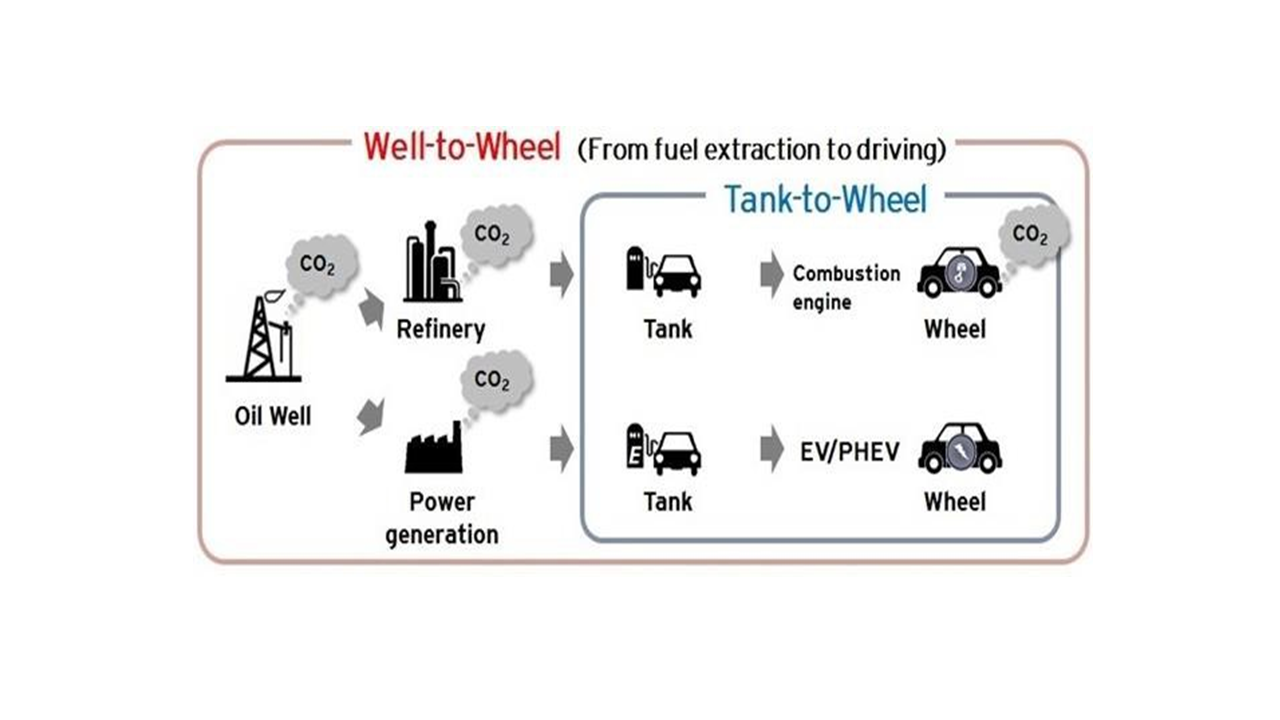
Step 2: Determination of consumption and transport data
When determining the consumption and transport data, different data categories can be used. The following figure “Different data categories” shows you the categories primary data, secondary data (program data and detailed modelling) and default data and their priority of use. Ideally, primary data is used to calculate GHG emissions, especially for scope 1 reporting of own emissions. Ideally, scope 3 emissions are also calculated using primary data. However, as this is not always available, secondary data (e.g. from green freight programmes for scope 3 reporting or from detailed models) can also be used. Only if neither primary nor secondary data is available, default data (e.g. from ISO standards) should be used.

Step 3: Determination of emission factors
The following figure “Shares of WTT and TTW in WTW” shows the shares of well to tank (WTT) from fuel production and distribution and TTW from fuel combustion in the WTW (fuel life cycle emissions). It can be stated that the calculated emissions when burning 100% biodiesel are only from the fuel production and distribution (WTT). When using diesel, only around 16 % of the emissions are generated during production and distribution, while around 84 % are generated during fuel combustion. The figure shows why it is important to consider not only the TTW but also the WTT emissions, as this is the only way to map the entire fuel life cycle emissions.

The emission factors or GHG intensity values are calculated for both electricity and fuel by dividing the kg CO2e by the kWh of electricity or kg of fuel and are given in g CO2e/MJ or kg CO2e/kg. In the case of freight transport, the CO2e per tonne-kilometer or equivalent units and for freight throughput at the hub the CO2e per metric ton are used. Furthermore, the following denominators are commonly used in the logistics industry:
- Ton kilometres (tkm) or vehicle kilometres (vkm)
- Pallets or boxes delivered
- TEU or TEU-km
The figure "Calculation of emission factors/intensity value" shows the calculation of the GHG intensity value per pallet delivered. In this example, the delivery of all pallets (200 pieces) leads to 700 kgCO2e. So per pallet, 3.5 kgCO2e are emitted.
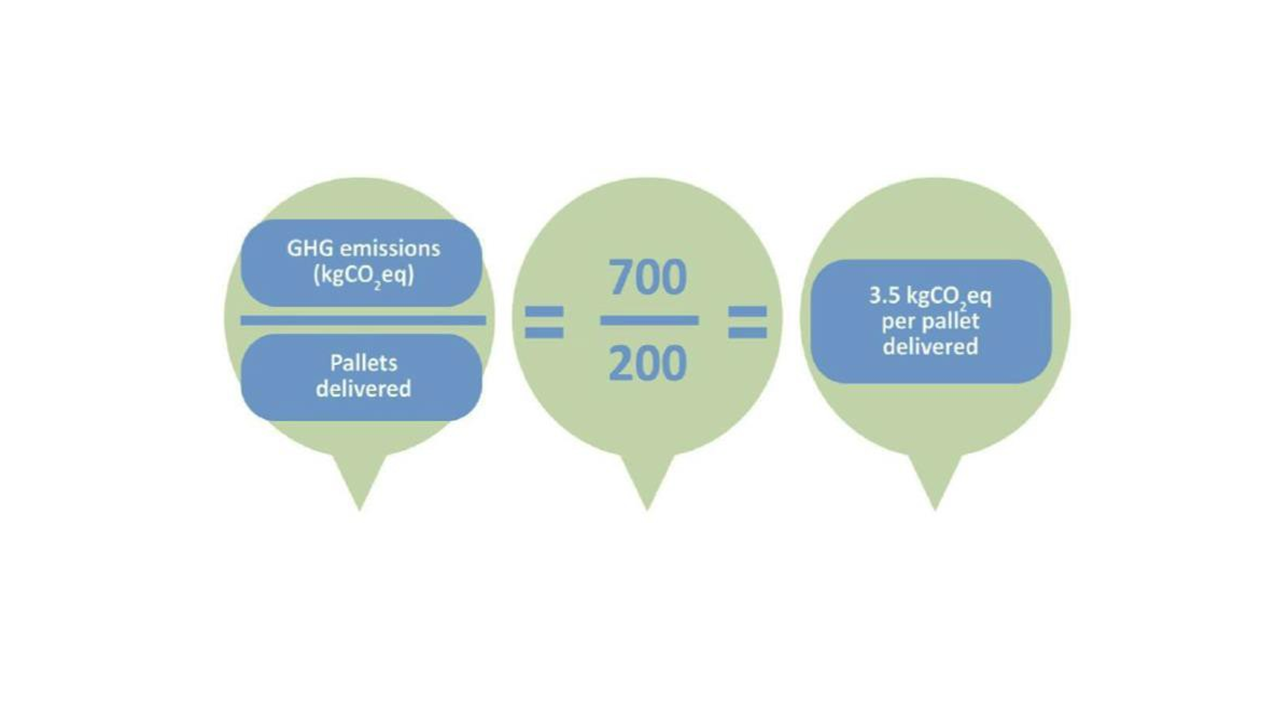
Step 4: Calculation of GHG emissions
Once the system boundaries have been defined and the consumption and transport data as well as the emission factors have been determined, the greenhouse gas emissions can be calculated. For this purpose, carbon calculators can be used.
You can find many carbon calculators online. They are developed by national or local governments, NGOs or consulting firms.
- A few examples:
- CarbonCare Asia Ltd.: https://www.carboncareasia.com/eng/Carbon_Solutions/Carbon_Calculators.php
- Carbon Footprint Ltd.: https://www.carbonfootprint.com/calculator.aspx
- Hong Kong Environment Bureau: https://www.carboncalculator.gov.hk/en
- The Nature Conservancy, USA: https://www.nature.org/en-us/get-involved/how-to-help/carbon-footprint-calculator/
- The Resurgence Trust: https://www.resurgence.org/resources/carbon-calculator.html
- USEPA: https://www3.epa.gov/carbon-footprint-calculator/
- WWF, UK: https://footprint.wwf.org.uk
EcoTransIT World
Another carbon calculator is the EcoTransIT World. It is a very useful tool to calculate emissions caused from logistics activities, like transport, handling and storage. It is based on IPCC Assessment Reports about knowledge on climate change, its causes, potential impacts and response options and the ISO 14083 and the real data of companies. The figure "Structure of EcoTransIT" shows the different components of the tool. As a user, you need to insert the transport details (gross weight in tonnes or as TEU) and also other data like origins, destinations, waypoints, the mode of transport and a transport description. EcoTransIT is then doing the calculation by using automatic transport parameters from proven sources. It then gives the results for the different emissions for WTT and TTW.
The system covers the following information:
- Transport goods and volume
- Environmental parameters of each transport process
- Route characteristics and length
- Degree of capacity utilisation
- Vehicle size and drive type
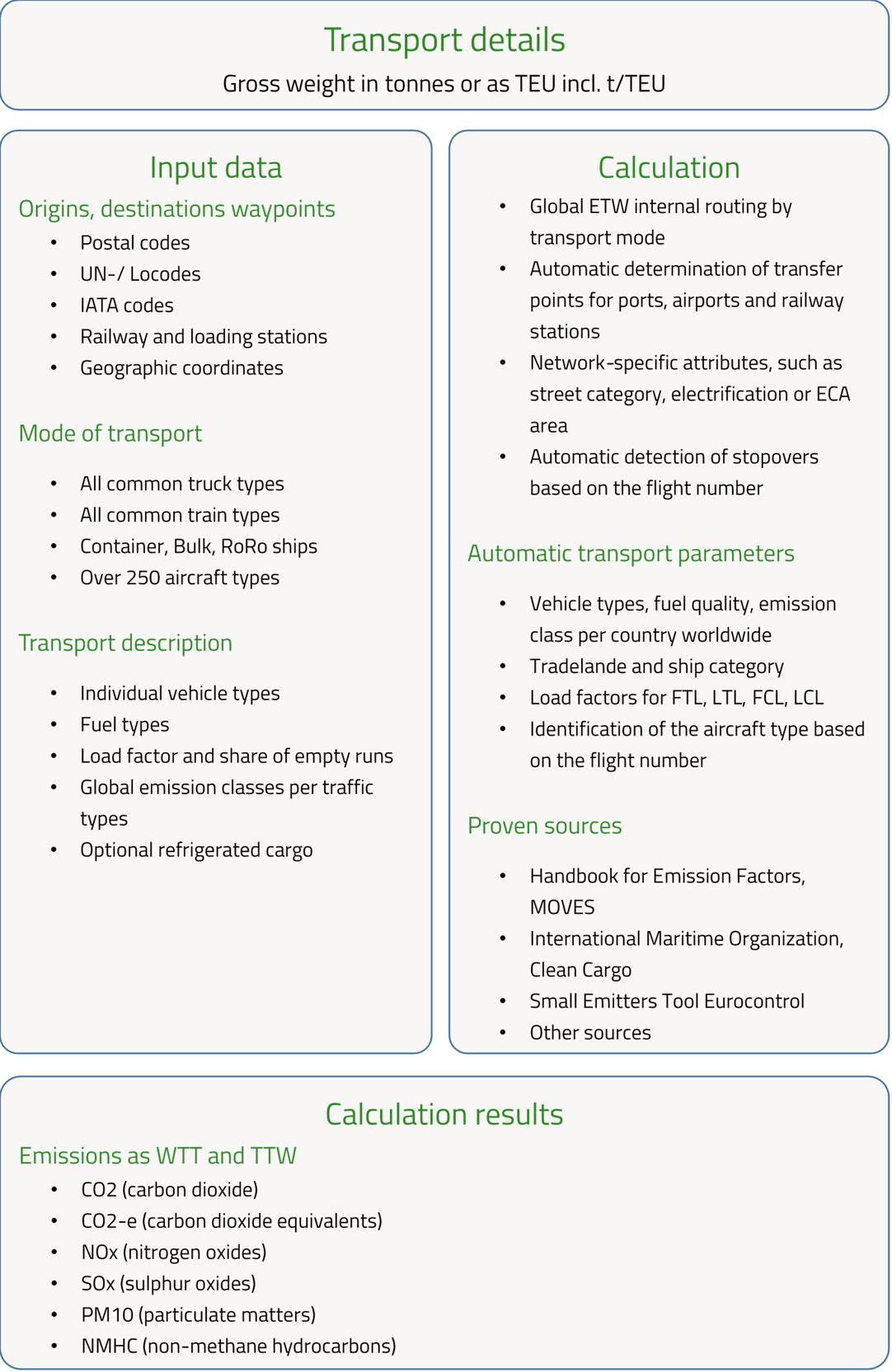
Follow this link to test the EcoTransIT Calculator: https://emissioncalculator.ecotransit.world/
After calculating the emissions, the results must be documented in step 5.
PDCA–Cycle (Plan Do Check Act)
To carry out the environmental analysis in accordance with ISO 14001 and ISO 14083 the PDCA-Cycle can be used. The PDCA Cycle describes an iterative four-phase problem-solving process that has its origins in quality assurance.
ISO 14001 focuses on a continuous improvement process as a means of achieving the defined objectives in relation to the environmental performance of an organisation (company, service provider, authority, etc.). The continuous improvement process is based on the Plan-Do-Check-Act (PDCA) method:
- Plan: defining the objectives and processes to achieve the implementation of the organisation's environmental policy
- Do: the implementation of the processes
- Check: Monitoring the processes with regard to legal and other requirements and objectives of the organisation's environmental policy; publishing the environmental performance (the organisation's success with regard to its environmental protection measures), if applicable
- Act: If necessary, the processes must be corrected (adapted)
The figure “PDCA-Cycle - Plan Do Check Act for environmental reporting” shows the different components, that need to be included when doing an environmental reporting.
The basis of the entire process is continuous documentation and communication and the clear definition of responsibilities for the planned measures and tasks.
In the case of environmental reporting, the environmental goals and programmes must be planned (Plan). The measures must then be implemented (Do), followed by an internal environmental audit and a management review at least once a year (Check). If the check shows that the measures are not effective, they must be changed (Act). The results are used for the ISO 14001 audit, which has an impact on the environmental policy. The environmental policy is also influenced by the status analysis and itself has an impact on the environmental goals.
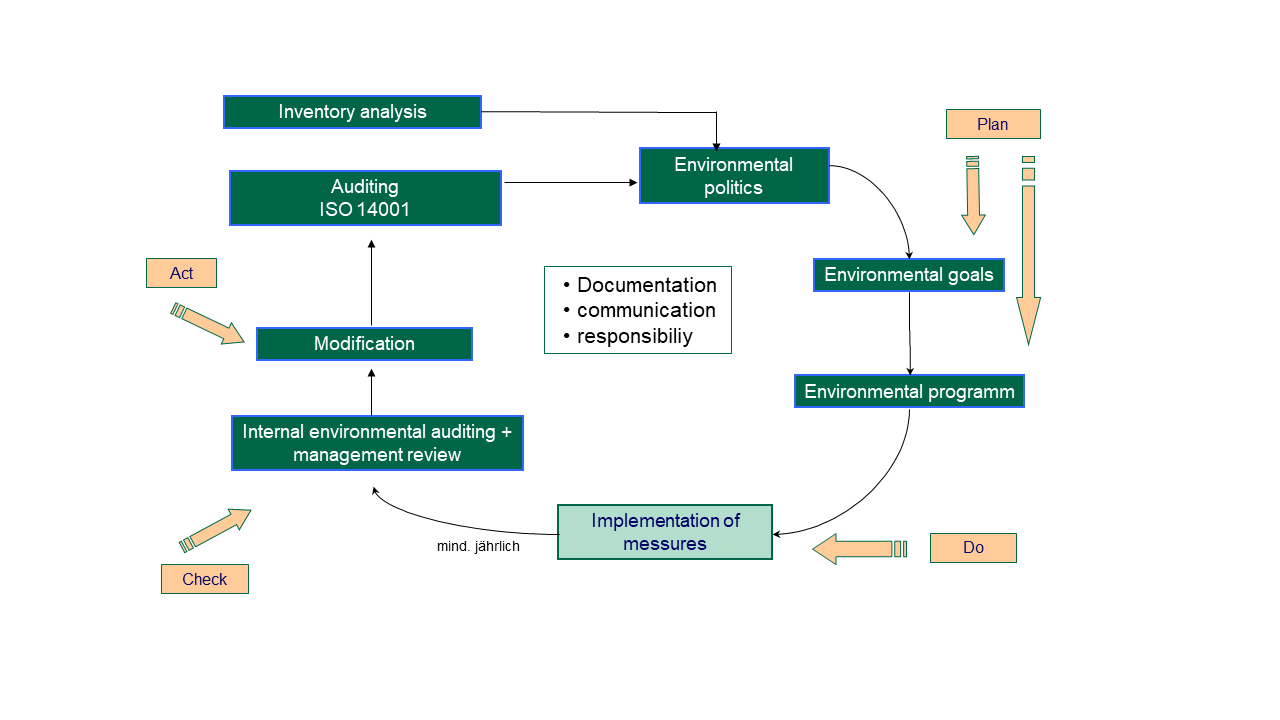
Calculate the ecological and social impact
To evaluate whether a certain measure will be more ecologically friendly than another, you can use the following method to calculate CO2-emissions resulting from transport. The following figure "Determining ecological and social impacts and resource consumption and approaches for reducing transport-related environmental impacts" shows, how to calculate the ecological and social impact and resource consumption and how this consumption might be reduced.
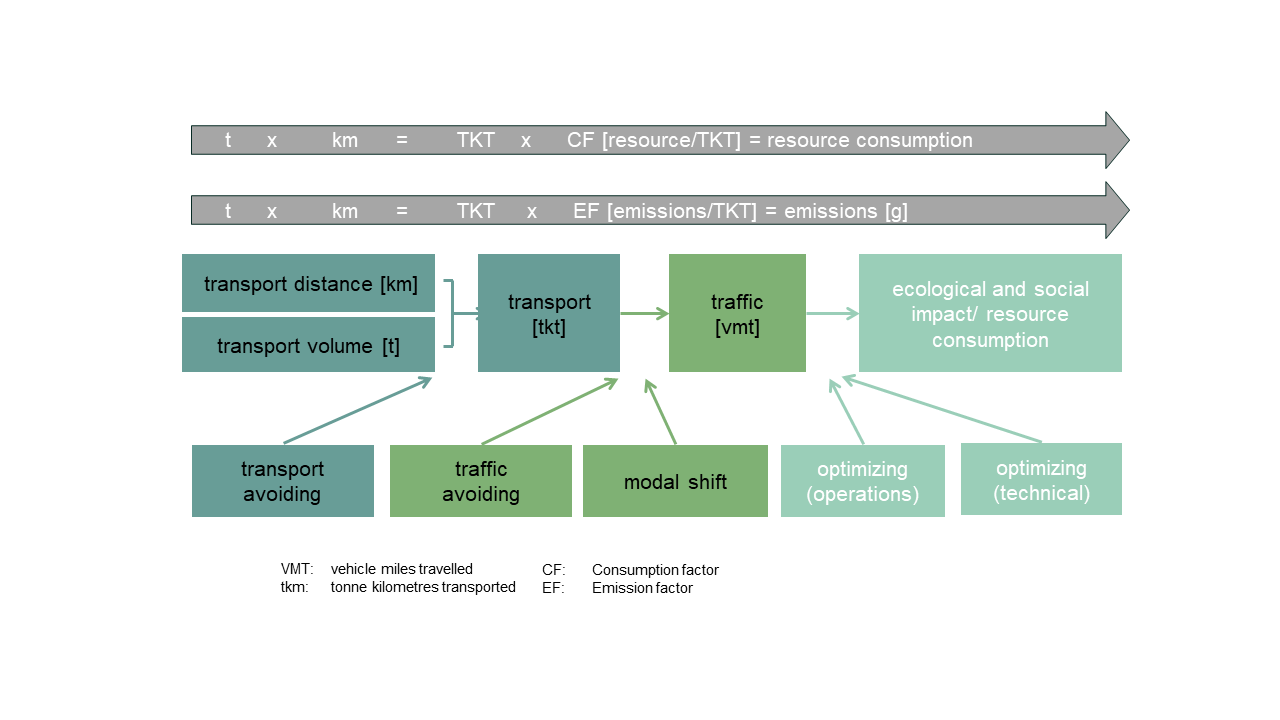
With the multiplication of the transport distance [km] and the transport volume [t] you are able to calculate the tonne kilometres transported [TKT]. By multiplying the TKT with an emission factor (EF) [emissions/TKT] or with a consumption factor (CF) [resource/TKT] you can calculate the emissions [g] or the resource consumption [g]. The EF and the CF are dependent on the used mode of transport, so you need the vehicle miles travelled [VMT] to evaluate the whole ecological and social impact or resource consumption.
In transport, the main control variables are:
- the transport distance,
- the transported quantities (weight, volume) as well as
- the choice of the means of transport and
- its capacity utilisation.
Other important influencing factors are:
- the vehicle technology (e.g. type of means of transport, size, engine power, fuel used or traction type/energy mix and upstream chains),
- the operation (e.g. speed, driving behaviour, altitude) and
- the environmental and surrounding conditions (e.g. topography, flow conditions, weather).
For designing a more environmentally friendly product lifecycle, transportation is only one lever (keyword "local sourcing"). The sustainability of the freight transport depends mainly on the factors transport volume (weight, volume), transport distance, used mode(s), used concrete vessels and the degree of utilisation (load factor). To design a more environmentally friendly product life cycle in the area of transportation we should avoid transports (increase capacity utilization), shift transports (from road to rail), reduce speed (slow steaming), increase fuel quality (carbonization content in heavy fuel oil), etc. Both the shipper and the carrier can contribute to making transport more environmentally friendly with their decisions. The shipper can primarily influence the transport volume and distance, while the carrier can primarily influence the used mode and vessel as well as the load factor. The used mode of transport and load factor can also be influenced by the shipper if the shipper specifies which mode of transport is to be used and if the transport is only carried out when a sufficiently high load is available.
The following guidance can help companies if they want to reduce their GHG emissions from freight transport.
The first step (A) consists of raising awareness of the topic, whereby accountability must be institutionalised and targets formulated. The second step (B) involves balancing, where balancing limits need to be determined, prepared and implemented. The next step (C) involves designing, in which the reduction measures must be selected and implemented. The final step (D) involves analysing, evaluating and disseminating the results.
The process is continuously improved and steps B, C and D in particular are repeated again and again in order to achieve the short, medium and long-term goals.
The following figure “Guidance for companies on reducing transport related GHG emissions” shows the relevant aspects of raising awareness, balancing, design such as analyse and evaluate with respect to the level of goals in terms of short-term goals up to long-term goals. The repetition of the process and the individual steps depends on the desired goal and its temporal horizon.
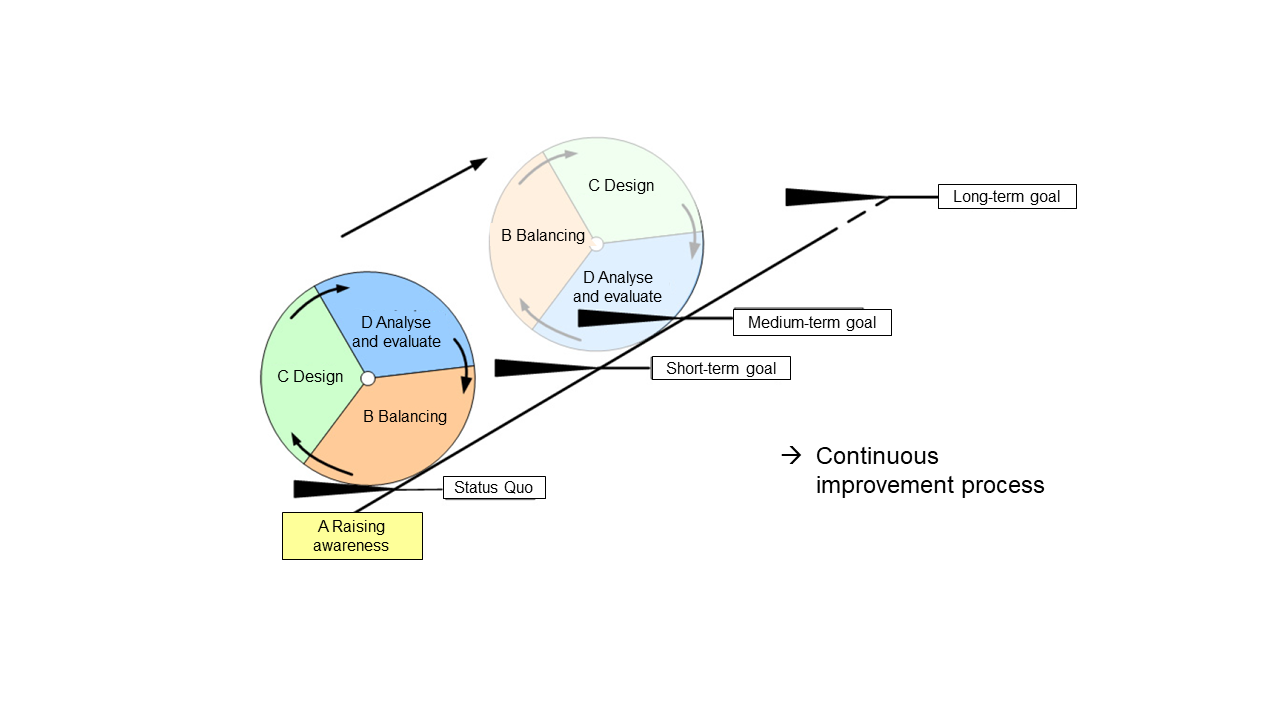
You have now learnt more about the environmental dimension of sustainability and know how to calculate transport emissions. You have also gained an insight into who can take what steps to improve the sustainability of transport and how this improvement process can be organised. On the next page, you will learn more about the economic dimension of sustainability.
Sources
Bundesministerium für Umwelt, Naturschutz, nukleare Sicherheit und Verbraucherschutz (2024) Europäische Lieferkettenrichtlinie (CSDDD). URL: https://www.bmuv.de/themen/nachhaltigkeit/wirtschaft/lieferketten/europaeische-lieferkettenrichtlinie-csddd (last access: 06.06.2024)
Bundestag (2021): Act on Corporate Due Diligence Obligations in Supply Chains. URL: https://www.bmas.de/SharedDocs/Downloads/DE/Internationales/act-corporate-due-diligence-obligations-supply-chains.pdf?__blob=publicationFile&v=4 (last access: 06.06.2024)
Crippa, M., Guizzardi, D., Solazzo, E., Muntean, M., Schaaf, E., Monforti-Ferrario, F., Banja, M., Olivier, J.G.J., Grassi, G., Rossi, S., Vignati, E. (2021): GHG emissions of all world countries - 2021 Report, EUR 30831 EN, Publications Office of the European Union, Luxembourg, 2021, ISBN 978-92-76-41547-3
Deutschlandfunk (2022): Worum es bei der EU-Taxonomie geht https://www.deutschlandfunk.de/taxonomie-104.html (last access: 06.06.2024)
DIN EN ISO 14001:2015-11 (2015): Environmental management systems - Requirements with guidance for use
DIN EN ISO 14040:2021-02 (2021): Environmental management - Life cycle assessment - Principles and framework
DIN EN ISO 14044:2021-02 (2021): Environmental management - Life cycle assessment - Requirements and guidelines
DIN ISO 14083:2023-03 (2023): Treibhausgase - Quantifizierung und Berichterstattung über Treibhausgasemissionen von Transportvorgängen
EcoTransIT (2024): EcoTransIT World. URL: https://www.ecotransit.org/en/ (last access 24.05.2024).
EN 16258:2021 (2021): Methodology for calculation and declaration of energy consumption and GHG emissions of transport services (freight and passengers)
EN ISO 19011:2002 (2002): Guidelines for quality and/or environmental management systems auditing
European Commission (2022): DIRECTIVE OF THE EUROPEAN PARLIAMENT AND OF THE COUNCIL on Corporate Sustainability Due Diligence and amending Directive (EU) 2019/1937. URL: https://eur-lex.europa.eu/legal-content/EN/TXT/?uri=CELEX%3A52022PC0071 (last access: 06.06.2024)
EU Kommission (2022): EU-Taxonomie: Kommission legt ergänzenden delegierten Klima-Rechtsakt vor, um die Dekarbonisierung zu beschleunigen. URL: https://ec.europa.eu/commission/presscorner/detail/de/ip_22_711 (last access: 06.06.2024)
European Union (2022): Directive (EU) 2022/2464 of the European Parliament and of the Council of 14 December 2022 amending Regulation (EU) No 537/2014, Directive 2004/109/EC, Directive 2006/43/EC and Directive 2013/34/EU, as regards corporate sustainability reporting (Text with EEA relevance). URL: https://eur-lex.europa.eu/legal-content/EN/TXT/?uri=CELEX:32022L2464 (last access: 06.06.2024)
Flämig et al. (2009): Die LOTUS-Methodik – Logistics towards Sustainability.
Flämig, H. (2015): Logistik und Nachhaltigkeit. In: Heidbrink, Ludger; Meyer, Nora; Reidel, Jo-hannes; Schmidt, Imke (Hrsg.): Corporate Social Responsibility in der Logistikbranche - An-forderungen an eine nachhaltige Unternehmensführung. Berlin: E. Schmidt, 2015. S. 25-44.
G8 Summit (2007): Climate Change, Energy Efficiency and Energy Security. Summit Declaration (7 June 2007). URL: https://www.g-8.de/Content/EN/Artikel/__g8-summit/anlagen/2007-06-07-gipfeldokument-wirtschaft-eng,templateId=raw,property=publicationFile.pdf/2007-06-07-gipfeldokument-wirtschaft-eng.pdf (last access 31.05.2024)
GHG Protocol (2011): Corporate Value Chain (Scope 3) Accounting and Reporting Standard. [online] https://ghgprotocol.org/sites/default/files/standards/Corporate-Value-Chain-Accounting-Reporing-Standard_041613_2.pdf (last access 13.06.2022).
GHG Protocol (2016): Global Warming Potential Values URL: https://www.ghgprotocol.org/sites/default/files/ghgp/Global-Warming-Potential-Values%20%28Feb%2016%202016%29_1.pdf (last access 31.05.2024)
GLEC Framework (2019): Global Logistics Emissions Council Framework for Logistics Emissions Accounting and Reporting. URL: https://www.feport.eu/images/downloads/glec-framework-20.pdf (last access 24.05.2024).
Greenhouse Gas Reduction Strategies in the Transport Sector (2008) - Preliminary Report; The International Transport Forum (ITF). URL: http://http://www.internationaltransportforum.org/Topics/CO2AbatementPDFs/WorldCO2.pdf
ISO 26000:2010-11 (2010): Guidance on social responsibility
McKinnon und Alan (2018): Decarbonizing logistics - distributing goods in a low-carbon world. URL: https://www.climatecouncil.ie/media/climatechangeadvisorycouncil/Transpor%20Transition%20Paper%202%20McKinnon%20Decarbonising%20Freight.pdf (last access 24.05.2024).
Mundancas Climaticas (2019): The Economics of Climate Change URL: http://mudancasclimaticas.cptec.inpe.br/~rmclima/pdfs/destaques/sternreview_report_complete.pdf, Part I-II (last access 13.06.2022).
Stern, N. (2006) Stern Review: The Economic of Climate Change.
URL: http://mudancasclimaticas.cptec.inpe.br/~rmclima/pdfs/destaques/sternreview_report_complete.pdf (last access 31.05.2024)
Umwelt Bundesamt (2022): Die Treibhausgase. URL: https://www.umweltbundesamt.de/themen/klima-energie/klimaschutz-energiepolitik-in-deutschland/treibhausgas-emissionen/die-treibhausgase#undefined, https://www.ghgprotocol.org/sites/default/files/ghgp/Global-Warming-Potential-Values%20%28Feb%2016%202016%29_1.pdf (last access 07.06.2024).
Umwelt Bundesamt (2022): Straßenverkehrslärm. URL: https://www.umweltbundesamt.de/themen/laerm/verkehrslaerm/strassenverkehrslaerm (last access: 31.05.2024)
Umwelt Bundesamt (2023): Umwelt und Verkehr. URL: https://www.umweltbundesamt.de/bild/infografik-umwelt-verkehr (last access 24.05.2024).
United Nations (2015): Paris Agreement. URL: https://unfccc.int/sites/default/files/english_paris_agreement.pdf (last access: 31.05.2024)
World Resources Institute and World Business Council for Sustainable Development (2004):
Greenhouse gas protocol, A corporate accounting and reporting standard. ISBN 1-56973-568-9. URL: https://ghgprotocol.org/sites/default/files/standards/ghg-protocol-revised.pdf (last access: 06.06.2024) .
Zhou (2020): Carbon Footprint Measurement. In: Carbon Management for a Sustainable Environment, pp 25-67.https://link.springer.com/content/pdf/10.1007%2F978-3-030-35062-8_2.pdf